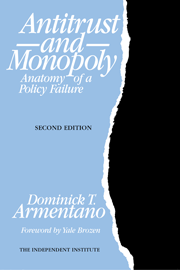The expressed goal of the Clinton Administration’s proposed regulations on cigarettes and smokeless tobacco products is to reduce adolescent consumption by one half. Roughly three million American juveniles smoke and an additional one million young males use smokeless tobacco. Putting aside (for the moment) all of the other difficulties with the new regulations, can they possibly accomplish their objective?
The government proposes severe new restrictions on the advertising of cigarettes under the mistaken assumption that there is a direct relationship between advertising and the decision to begin smoking. But there is little reliable evidence in the literature to support this contention and plenty of evidence to contradict it.
Juvenile smoking actually increased in Finland after a complete ban on tobacco advertising was implemented in 1978. Norway, which completely prohibited tobacco advertising in 1975, has a higher percentage of juvenile smokers than does the United States. And black teens in the United States, presumably exposed to the same persuasive advertising as white teens, have far lower smoking rates.
It is widely acknowledged (outside of Washington) that the decision to start using tobacco products is influenced primarily by culture, family, and peer pressure, not corporate advertising. So banning brand-name event sponsorships, or limiting cigarette brand logos on race cars and drivers’ uniforms, will have no measurable effect on any ten-year-old’s decision to light up.
FDA Commissioner David Kessler would have us believe that billboards near playgrounds and the use of cigarette brand names on t-shirts (which would all be prohibited under the new regulations) have created a teen-smoking health epidemic. Nonsense. The marginal increase in teen smoking recorded since 1991 is easily swamped by the longer-term steadily downward trend.
Listening to the FDA one would never know that the percentage of high school seniors who smoke daily has fallen from over 28 percent in 1977 to less than 20 percent in 1994. Heavy smoking (half a pack or more per day) among high school seniors had declined from 17.9 percent in 1975 to approximately 11 percent today. Yet the Administration now proposes to restrict tobacco advertising in teen-oriented magazines to a black-and-white, text-only format even though there is no evidence that such publishing censorship would impact teen cigarette consumption.
The bottom line is that these new regulations have little to do with changing cigarette consumption by teenagers. What they will do, however, is hurt certain advertisers, promoters of sporting events, tobacco manufacturers and their employees, and vending machine owners. Even more importantly, they will enhance the power of government bureaucrats to exercise additional control over private markets and lifestyles. And that’s what the antismoking crusade is really all about.
Make no mistake about it. The FDA would like to severely restrict the sale of all cigarettes in the United States. The Administration knows that total prohibition is politically impractical at the moment so it starts the crusade with regulations that aim to protect the children. And when these fail, as they must, the regulators will return with stronger recommendations and sterner controls.
But controls are already a way of life in this industry. Laws addressing tobacco sales to minors are on the books in every state and the District of Columbia. Dozens of governmental agencies, including the Department of Health and Human Services, the Federal Trade Commission, and the Bureau of Alcohol, Tobacco and Firearms, already police and regulate the industry. Every state taxes cigarettes and most lump a sales tax on top of the excise tax. Cigarettes are already among the most taxed and regulated products in America.
The Administration has invited public comment, so it should be told that its new regulations will not affect teen smoking but will, instead, reduce employment and income in tobacco-related industries. It should also be told that its contrived rationale to regulate cigarettes as a medical device is as phony as a three-dollar bill. Finally it should be told that freedom and persuasion, not censorship or regulation, are the primary social values that we choose to pass on to our children . . . whether they smoke or not.
Teen Smoking: The New Prohibition
Also published in The Freeman
This article is reprinted with permission from The Freeman, January 1997. © Copyright 1997, the Foundation for Economic Education.
Dominick T. Armentano is a Research Fellow at the Independent Institute and professor emeritus in economics at the University of Hartford (CT).
Civil Liberties and Human RightsCulture and SocietyFamilyFDA and Drug RegulationHealth and HealthcareLaw and Liberty
Comments
Before posting, please read our Comment Policy.








